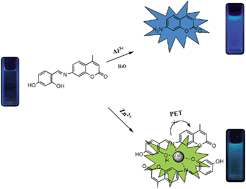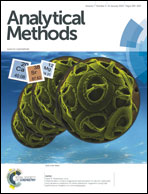The design of a simple fluorescent chemosensor for Al3+/Zn2+via two different approaches†
Abstract
In this study, we have developed a simple fluorescent sensor, 7-(2′,4′-dihydroxybenzylideneimino)-4-methyl coumarin, which shows a high selectivity towards Al3+/Zn2+ over a wide range of metal ions. On the one hand, the fluorescence intensity of the probe shows significant fluorescence enhancement in the presence of Al3+ at 427 nm (λex = 357 nm), which might be mainly attributable to the hydrolysis of imines. On the other hand, the receptor exhibits a selective response to Zn2+ at 489 nm (λex = 405 nm), and a photoinduced electron transfer process (PET) is proposed to explain the observed spectral response.

- This article is part of the themed collection: Alzheimer's Research Month 2016

 Please wait while we load your content...
Please wait while we load your content...